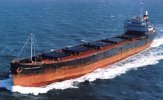Maybe.. but I have seen companies drag their feet in taking corrective action after a 'non-conformity' report was submitted. Back in the days before Safety Management Systems, if there was a problem getting the company to correct a safety deficiency I had at times asked Coast Guard inspectors to write me a CG-835 [CG 'fix it ticket'] to force the company to expedite the repair/correction.
I think everybody was aware of the ship's condition.. It wasn't a secret.. The records showed that during the last 2 years of her life the MARINE ELECTRIC had upwards of 400 doublers or patches placed on her hatch lids and over a dozen doubler plates on the main deck between the hatches. Doublers and epoxy patches were the standard means of repairing the wastage and also of stevedore damage caused in offloading coal. I remember once talking to a guy at the union hall that had 'night mated' her a few months before she sank.. He told me, besides the numerous hatch and deck repairs, he had also seen holes in the hull in the area of the load waterline where DC plugs had been driven in, sanded down flush and then cover with 'Red Hand' epoxy..


